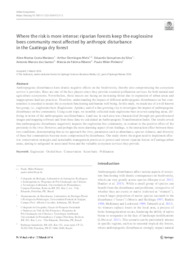Where the risk is more intense: riparian forests keep the euglossine bees community most affected by anthropic disturbance in the Caatinga dry forest.
Where the risk is more intense: riparian forests keep the euglossine bees community most affected by anthropic disturbance in the Caatinga dry forest.
Autoria: MARIANO, A. M. C.; MELO, A. D.; SILVA, E. G. da; SANTOS, A. M. dos; RIBEIRO, M. de F.; PINHEIRO, P. M.
Resumo: Anthropogenic disturbances have drastic negative effects on the biodiversity, thereby also compromising the ecosystem service it provides. Bees are one of the key players since they provide essential pollination services for both natural and agriculture ecosystems. Nevertheless, these insects are facing an increasing threat due to expansion of urban areas and inappropriate land use practices. Therefore, understanding the impact of different anthropogenic disturbances on bee communities is essential to assure the ecosystem functioning and human well-being. In this study, we made use of a well-known bee group, i.e., euglossine bees (Euglossine: Apidae), and of a fast-growing city to investigate the impact of anthropogenic disturbance on bee community. Using scent traps, we monthly collected male euglossine bees in seven sampling areas, differing in terms of the anthropogenic use/disturbance. Land use in each area was characterized through pre-georeferenced images and mapping software and from these data we calculated an Anthropogenic Transformation Index. Our results reveal that anthropogenic disturbance negatively impacts the euglossine bee community, in contrast to the positive effect of the proximity to the river. However, and perhaps the most alarming aspect of our findings, is the interaction effect between these two conditions, demonstrating that as we approach the river, parameters such as abundance, species richness, and diversity of these bee communities become more compromised by disturbance. Our study shows the urgent need to implement effective conservation strategies and sustainable management practices to protect and restore riparian forests in Caatinga urban areas, aiming to safeguard its associated biota and the valuable ecosystem services they provide.
Ano de publicação: 2024
Tipo de publicação: Artigo de periódico
Unidade: Embrapa Semiárido
Palavras-chave: Abelha, Abelhas de orquídeas, Biodiversidade, Caatinga, Comunidade de abelhas, Ecossistema, Euglossini, Floresta seca, Iscas perfumadas, Mata Ciliar, Polinização
Observações
1 - Por padrão são exibidas publicações dos últimos 20 anos. Para encontrar publicações mais antigas, configure o filtro ano de publicação, colocando o ano a partir do qual você deseja encontrar publicações. O filtro está na coluna da esquerda na busca acima.
2 - Para ler algumas publicações da Embrapa (apenas as que estão em formato ePub), é necessário ter, no celular ou computador, um desses softwares gratuitos. Sistemas Android: Google Play Livros; IOS: iBooks; Windows e Linux: software Calibre.
Acesse outras publicações
Acesse a Base de Dados da Pesquisa Agropecuária (BDPA) para consultar o acervo completo das bibliotecas da Embrapa.

